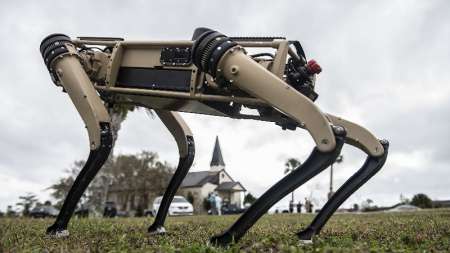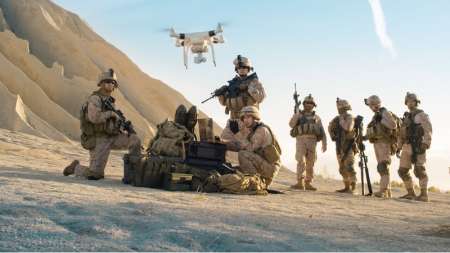The United States is leading the world in the development and use of AI with China close behind, according to a new report. […]
New working conditions have led agencies to adjust AI adoption methods and strengthen data analytics capabilities by leveraging commercially available solutions from industry and implementing other practices during the pandemic. […]
The White House announced the creation of the National Artificial Intelligence Initiative Office within the White House Office of Science and Technology Policy today, taking further steps to advance the research, development, and adoption of AI across the United States. […]
The U.S. Department of Health and Human Services (HHS) named Oki Mek, a career public servant, its first Chief Artificial Intelligence Officer (CAIO) in Dec. 2020, according to his LinkedIn. This is a new CXO-level position that puts Mek at the head of AI strategy for the agency. […]
The pace of government adoption of artificial intelligence (AI) and machine learning (ML) technologies remains too slow in the face of amplified technology reliance due to the coronavirus pandemic. […]
On Dec. 15, the U.S. Air Force (USAF) flew with artificial intelligence (AI) as a working aircrew member on a military aircraft for the first time. The AI algorithm – known as ARTUµ – flew on a U-2 Dragon Lady with Maj. “Vudu” on a test flight that “was the result of years of concerted […]
The shift to remote work forced by the coronavirus pandemic has helped the Army’s Combat Capabilities Development Command (CCDC) – a component of Army Futures Command – identify security gaps, and work to improve IT security for offsite personnel, said Col. Gregory Smith, Military Deputy to the Director of the CCDC, at an AFFIRM webinar Dec. 16. […]
During the last weeks of the 116th Congress, H.R. 1250, a non-binding resolution to pursue a national artificial intelligence (AI) strategy, has passed the House. […]
Senior executives with Google Cloud emphasized at their first Public Sector Summit on Dec. 8 the work that the company has been doing with a variety of public sector organizations during the coronavirus pandemic, and one emerging silver lining to the health crisis: a big leap forward in IT modernization that will help government and academia during the recovery. […]
The Joint Artificial Intelligence Center (JAIC) is building partnerships to spread artificial intelligence (AI) knowledge and projects throughout the Department of Defense (DoD) while acting as an advisor to interested components, said Colonel Robert Kinney, missions director at JAIC. […]
Even as we enter the winter months, advances in IT continue to heat up as we anticipate the potential benefits and challenges of emerging technologies. Top of mind is the future promise of artificial intelligence (AI) to revolutionize government, but less discussed is the possibility of a freeze in AI productivity – a result of insufficient data sets or security concerns that prevent data sharing. […]
President Trump signed an executive order (EO) on Dec. 3 that sets forth guidelines for the use of artificial intelligence (AI) technologies for Federal civilian agencies, and a roadmap to implementing those guidelines that will out-last the current administration set to depart on January 20. […]
In a new report, the Government Accountability Office (GAO) is highlighting policy options to improve artificial intelligence (AI) tools that in turn can improve data access, create best practices, and improve health care delivery. […]
Marine Corp. Lt. Gen. Michael Groen, the recently installed director of the Defense Department’s (DoD) Joint Artificial Intelligence Center (JAIC), explained his vision for JAIC 2.0 in an address to reporters on Nov. 24, and what people should know about DoD’s AI aims going forward. […]
The U.S. Army is partnering up with Howard University as they continue to assist the Department of Defense (DoD) guide its research in developing its $7.5 million center of excellence meant to deliver AI technologies. […]
The Office of Management and Budget (OMB) has released guidance for regulating AI applications, pursuant to Executive Order 13859, “Maintaining American Leadership in Artificial Intelligence.” […]
The United States Air Force (USAF) is bringing “man’s best friend” into the 21st Century. Tyndall Air Force Base will be one of the first military bases to implement semi-autonomous robot dogs into their patrolling regiment. […]
In the Information Age, newly named director of the Defense Department’s (DoD) Joint Artificial Intelligence Center (JAIC) Lt. Gen. Michael Groen wants to make sure that the U.S. warfighter is prepared to take on challenges and be equipped with the technology to do so. […]
The Federal government is responsible for maintaining some very mature artificial intelligence (AI) models and many agencies are exploring AI pilot projects, with few projects in-between – but COVID has pushed agencies to advance their efforts, Federal officials noted in a discussion on AI. […]
The National Park Service (NPS) announced that it will pilot an autonomous shuttle service at Yellowstone National Park to help alleviate traffic congestion. […]
The National Academy of Public Administration (NAPA) has identified the use of artificial intelligence (AI) technologies as one of the challenges of public administration due to concerns over bias, security, and transparency. […]
While facial recognition technologies offer huge opportunities to Federal agencies, overcoming algorithmic biases with the help of diverse data sets is essential for full deployment, industry experts said Oct. 29 at General Dynamics Information Technology’s Women + Technology event produced in association with MeriTalk. […]
The National Oceanic and Atmospheric Administration (NOAA) has announced a partnership with Google to enhance environmental monitoring and weather prediction through AI and machine learning (ML) technologies. […]
The General Services Administration (GSA) and Department of Defense’s Joint AI Center (JAIC) are claiming five major achievements for their first year of joint work together that have accelerated JAIC’s operational maturity. […]
Defense Department (DoD) Deputy Chief Data Officer James Cully today emphasized the importance of keeping an open mind about how to work greater data capabilities into technology solutions as the Pentagon moves forward to execute on its data strategy released earlier this month. […]
Reps. Jerry McNerney, D-Calif., and Pete Olson, R-Texas – both co-chairs of the Congressional Artificial Intelligence Caucus – on Oct. 23 stumped for the AI in Government Act of 2020 (H.R. 2575) that passed the House last month and now sits on Senate general legislative calendar awaiting possible action. […]
The National AI Institute (NAII) is starting up a new AI Tech Sprint within the Department of Veterans Affairs (VA) which aims to empower an AI-enabled ecosystem through voluntary incentives linking Federal, industry, academia, and nonprofit organization ecosystems around AI R&D. […]
The Massachusetts Institute of Technology (MIT) Schwarzman College of Computing has convened the AI Policy Forum, which it said will provide “an overarching policy framework and tools for governments and companies to implement in concrete ways.” […]
Nand Mulchandani, chief technology officer of the Joint Artificial Intelligence Center (JAIC) within the Department of Defense (DoD), emphasized the need for trust in AI as a major part of the department’s deployment strategy. […]
Thanks to an $8 million investment from the U.S. Army, a swarm of hundreds of unmanned air vehicles will soon descend on unmanned ground vehicles to autonomously recharge. […]


















